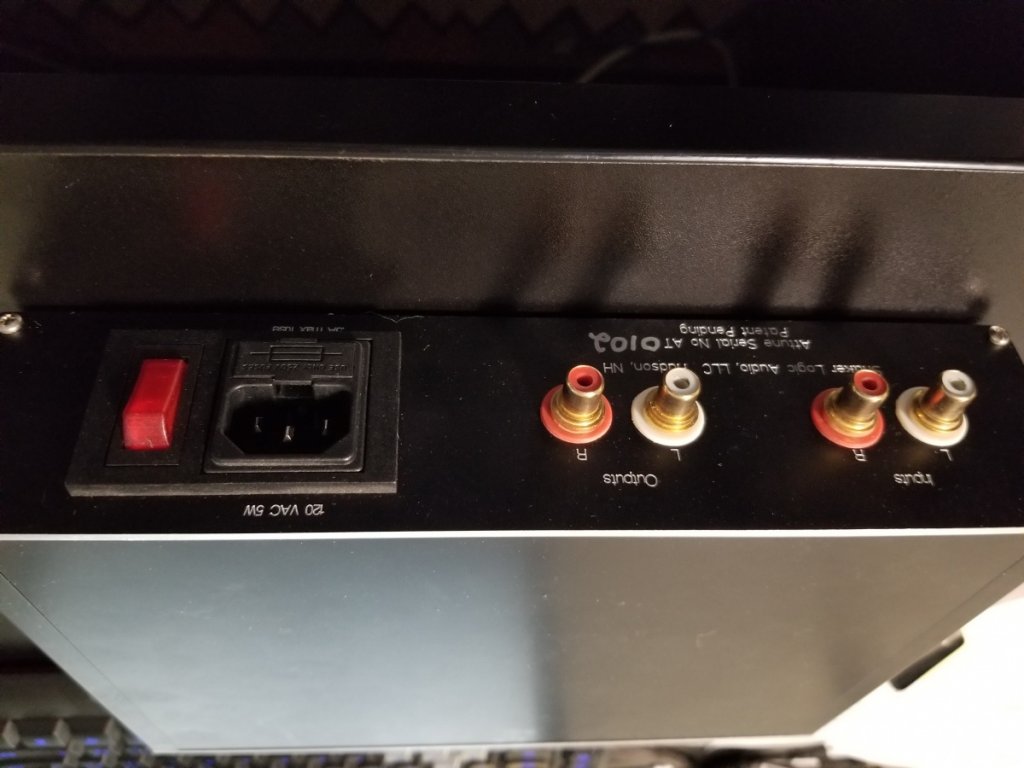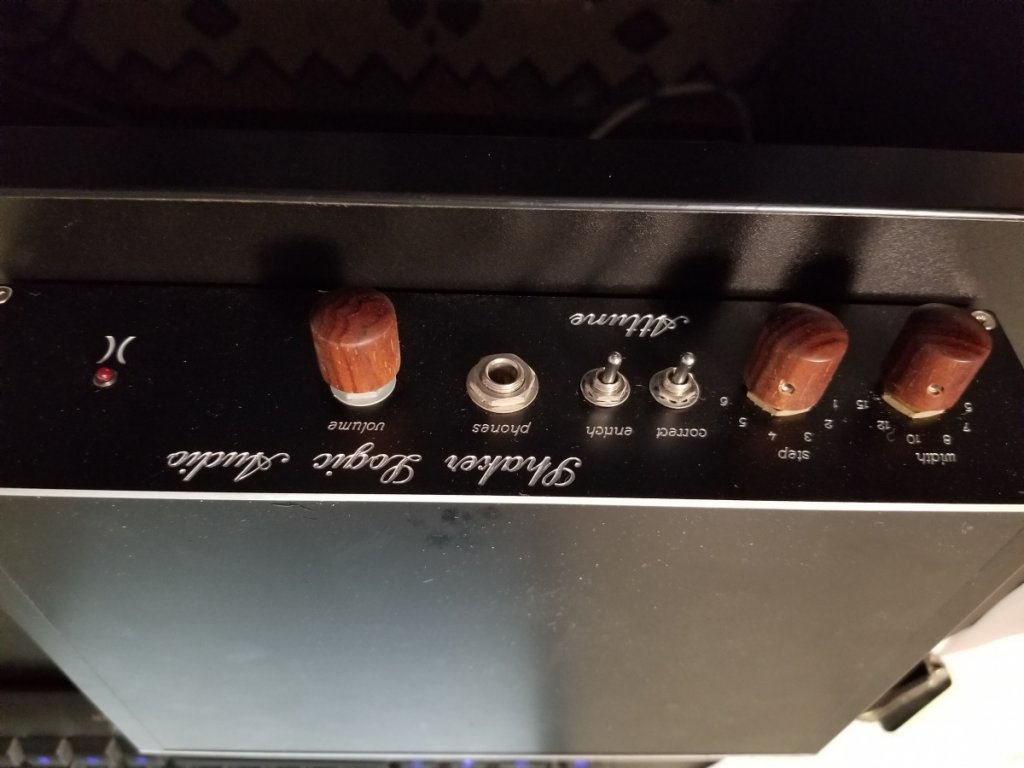About 5 years ago, a friend came over and put the Attune in my system. It is placed between the source (i.e. a CD player), and the preamp. The music immediately became more engaging, fuller and dynamic. By playing with the knobs I could increase/decrease the width and depth of the sound stage. I bought it immediately. In the years following as my system has evolved I have many times taken it out to see if it was still needed, but each time the music always became flat and less engaging. I always put it back in.
I am selling it for $500.00 for it which will include postage. It retailed for $1300. You can look at the my audiogon rating for davea33. I live in the Boston area so always willing to meet and/or demo.
Below are some excerpts from the manufacturer:
If you are an audiophile who is less than satisfied with your music system, the Attune is the single most important new component that you can buy. Rather than spending open-ended amounts of money on new cabling, tip-toes, contact enhancers, or other sound altering devices, sometimes known as “tweaks,” consider the purchase of a device that corrects the issues that undermine almost all loudspeakers and headphones.
The Attune augments a music system by correcting for the sound propagation losses associated with speakers that make reproduced music sound thin and overly-analytical. You will note that there are two adjustable parameters, one for step (distance between the loudspeakers and room boundaries) and the other for width (relative size of the speakers). Even the average music listener will note a significant difference in sound quality. Attune also carries an exceptionally high quality headphone amplifier. Therefore Attune serves the needs of both loudspeaker and headphone users.
The Attune is designed to correct for the propagation losses that occur in sound radiation patterns, be they produced by loudspeakers or headphones. Such losses are similar, but not identical for both types of acoustic transducers. The user may need to change settings when switching between loudspeaker and headphone usage in order to achieve optimum results.
The rear of the Attune displays a combination IEC power inlet, illuminated switch, and mini fuse tray. Voltage and power ratings are found above and below the IEC port. The ideal fuse is a .5A slow-blow type, although fast blow fuses may be used. Under no circumstances should a fuse capable of passing more than .5 amps (500 milliamps) of current be used.
The rear power rocker switch is internally illuminated. That is, when is it placed in the “On” position, it will light up. The power on state is also indicated by an LED which is on the right front, and is part of the stylized Shaker “Tree of Light” logo. When the unit is plugged in and neither position of the power switch results in illumination, then the fuse is blown and the unit should be returned for repair. It is definitely NOT recommended that the fuse be replaced multiple times, with increasing values, to see if the unit will power on. Doing so may result in serious personal harm, and/or destruction of the Attune itself.
Due to the very modest power draw of a correctly functioning Attune, the employed power cord need not be of high current capacity. Some users might find value in experimentation of power cords of different natures and or constructions, but such experimentation is definitely NOT required for the complete enjoyment of Attune’s capabilities.
The rear panel also houses two pair of RCA phono jacks. The pair labeled “Input” should be fed by a source signal device, such as a preamplifier’s main outputs, record outputs, or even a CD player, iPod, laptop, or other device capable of supplying analog audio signal. The “Output” jacks should feed a main power amplifier, or “tape monitor input” of the preamplifier. In old school terminology, the Attune can be placed into the tape loop of the preamplifier. The logical flow of the audio signal is: analog audio source->Attune->power amplification->loudspeakers
Note that the front volume control does not alter the level of the audio signal passing out of the “Output” jacks. Therefore, volume control for loudspeaker usage must be supplied by a device external to the Attune.
Right to left, the front panel of the Attune displays the fore-mentioned power indication/logo LED, a headphone volume control, a 1/4″ stereo phone jack, a mini-toggle switch marked “Enrich,” a mini-toggle switch labeled “Correct,” a six-position rotary switch labeled “Step,” and a six-position rotary switch labeled “Width.”
Setting aside the “Enrich” switch for a moment, there are three controls for the Attune’s circuit that correct for propagation losses in loudspeakers and headphones. Right to left, the first is the toggle switch that serves as on (up or “Correct” position) and off (down position). The next is the rotary switch labeled as “Step” with six positions number “1″ to “6.” This control engages increasingly strong correction/compensation such that position “1″ is the least, and “6″ is the strongest.
A loudspeaker that is positioned close to room boundaries (wall, floor, corner, ceiling) would need a setting at the lower end of the Step range. A loudspeaker that is positioned well out into the listening room and on stands would require a higher setting. Similarly, headphones that lie close to the listener’s ears, or which seal tightly to the head would require a lower setting, while ones that carry the sound transducers further away from the ear -or seal less tightly- would require a higher setting. In either speakers or headphones, it is usually best to start with a setting of “3″ or “4″ and experiment upwards and downwards from there.
The “Width” rotary switch is the last control. The settings range from “5″ to “15″ on this device. Very small speakers would need “5″ or “7″, while large speakers would require a larger number setting. It is usually best to choose the setting that most closely corresponds to the measured width of the front-facing side of the speaker, but optimum results might require experimenting with the selector up or down from the theoretically “best” setting.
For headphones, the “best” setting is usually “7″ but may differ significantly from that depending on whether or not the headphones are buds, closed-back, or open back. It is recommended that the user start with “7″ and experiment up and down and the best sound is achieved.
Returning to the “Enrich” toggle switch: its purpose is to engage (up) or disengage (down) a circuit that injects “shaped” information into the audio stream. The original low-level signals of a digitized audio stream are subject to losses arising from quantization error, and/or compression and decompression (i.e. MP3 processing). The injection of additional, relevant information by Attune can restore a sensation of “wholeness” that is sometimes lost to digital processing techniques.
The Attune retails at the price of $1,295.
Specifications:
Electronic
- Attune line output with correct and enrich disengaged: <.006% THD @ 1kHz, frequency response +/- .25db 20-20kHz, at 1Vac out
- Attune headphone output with correct and enrich disengaged: <.01% THD @ 1kHz, frequency response +/- .25db 20-20kHz, at 100mW output, >500mW output available
Electrical
- 110-130Vac main power, 5W dissipation maximum. .5A slo-blo fuse maximum
Physical dimensions
- 8″L x 9.5″W x 1.5″H, including feet, jacks, and knobs, 2.5 lb.s
Construction
- CNC machined panels from anodized/powder coated 2.5mm aircraft aluminum stock, all lettering mechanically engraved and paint filled
- Printed circuit boards (PCB’s) made in the U.S.A.
- All machining and assembly performed in the U.S.A.
- Control knobs handmade from hardwoods in the U.S.

